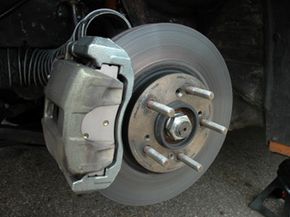
Brake calipers are essential to your car's ability to stop and are arguably one of the most important automobile brake parts. Most cars today have disc brakes, at least for the front wheels, anyway. But a lot of cars and trucks are now using disc brakes in the rear, too. In a disc-braking system the car's wheels are attached to metal discs, or rotors, that spin along with the wheels. The job of the caliper is to slow the car's wheels by creating friction with the rotors.
The brake caliper fits over the rotor like a clamp. Inside each caliper is
Advertisem*nt
a pair of metal plates bonded with friction material -- these are called brake pads. The outboard brake pads are on the outside of the rotors (toward the curb) and the inboard brake pads on the inside (toward the vehicle). When you step on the brake, brake fluid from the master cylinder creates hydraulic pressure on one or more pistons in the brake caliper, forcing the pads against the rotor. The brake pads have high-friction surfaces and serve to slow the rotor down or even bring it to a complete halt. When the rotor slows or stops, so does the wheel, because they're attached to one another.
Older cars and trucks used drum brakes, where the motion of the wheels is slowed by friction between a rotating drum and brake shoes mounted inside the drum. This friction caused heat and gases to build up inside the drum, which often resulted in a loss of braking power known as brake fade. Because the brake pads in disc brake systems are external to the disc rather than contained within a drum, they are more easily ventilated and heat doesn't tend to build up quite as fast. For this reason, drum brakes have been largely replaced in modern vehicles by disc brakes; however, some less expensive cars still use drum brakes for the rear wheels, where less stopping power is required.
There are two main types of calipers: floating (or sliding) calipers and fixed calipers. Floating calipers move in and out relative to the rotor and have one or two pistons only on the inboard side of the rotor. This piston pushes the entire caliper when the brakes are applied, creating friction from the brake pads on both sides of the rotor. Fixed calipers, as the name implies, don't move, but rather have pistons arranged on opposing sides of the rotor. Fixed calipers are generally preferred for their performance, but are more expensive than the floating kind. Some high-performance fixed calipers have two or more pairs of pistons (or "pots") arranged on each side of the rotor -- some have as many as six pairs total.
Special tools are useful when working with brake calipers, especially when replacing the brake pads. We'll talk about that in the next section, and then discuss the different types of brake calipers available for different types of vehicles.
Advertisem*nt
Contents
- Brake Caliper Tool
- Motorcycle Brake Calipers
- Truck Brake Calipers
- Performance Brake Calipers
Brake Caliper Tool
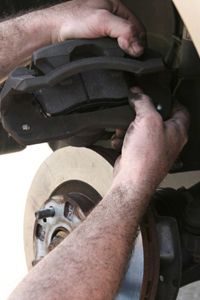
Brake pads don't last forever. Every time the pads in a disc brake system come in contact with the spinning rotor, they wear down a little. Gradually, these brake parts (the pads) become thinner and thinner. To compensate for this, the piston in the caliper emerges from the hollow cylinder where it resides inside the caliper. As it does so, it pushes the worn-down brake pads further and further inward toward the rotor. Eventually, the brake pads will need to be replaced with fresh, unworn pads. Unfortunately, the caliper piston (which is now nearly fully extended) makes it difficult to remove and replace the pads. The piston needs to be pushed back into the caliper.
This is where special brake pad tools come in. The job of a brake caliper tool is to retract the piston or pistons back into the caliper so that the brake pads can be easily removed and replaced. The piston can't simply be pushed back into the caliper because it's threaded, like a screw, and needs to be wound back in. While it is possible to use, say, a pair of pliers to do this, it isn't recommended. You can damage the piston, the caliper and your hands, too. The brake caliper tool typically fits over the piston at one end and has a handle at the opposite end that allows it to be rotated. As it rotates, the piston is wound back into the caliper.
Advertisem*nt
Floating calipers also need to be serviced if the pins that they slide on begin to stick. This is usually caused by dirt or rust. When this happens, the caliper cannot fully retract the brake pad from the rotor and friction continues, even when the brake pedal isn't being pushed. This can cause excessive wear on the pad, inefficiency in fuel use, and even warping of the rotor if enough heat builds up.
Up to this point, the description we've given of a brake caliper doesn't fully describe all models. In the following pages we'll look at more specialized types of calipers and see how they differ from the more common types.
Advertisem*nt
Motorcycle Brake Calipers
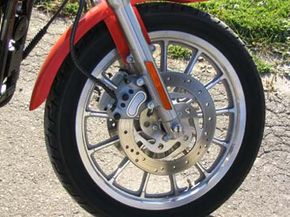
Motorcycles are smaller than automobiles and therefore need less stopping power. Nonetheless, the ability to slow down or stop is in some ways even more important on a motorcycle than in other vehicles. How so, you may ask? Well, since the driver is largely unprotected, even a small fender-bender can be potentially fatal. Accident avoidance is critical when you're riding a motorcycle. But what kind of brake calipers does a motorcycle need?
The answer is relatively simple -- small and light. Unlike the larger calipers used on some cars and trucks, motorcycle brake calipers must be kept small to avoid weighing down the bike and getting in the way of the rider. Motorcycle brake calipers are commonly made of lightweight materials such as aluminum, which also has the
Advertisem*nt
added advantage of being rustproof. Some motorcycles are bigger and more powerful than others; obviously, those bikes need more stopping power. Many smaller,
less-powerful bikes still use drum brakes, but most of the larger bikes now have disc brakes -- especially on the front wheel. To increase the stopping power, calipers on more powerful motorcycles typically have multiple pistons. Some have two or even four pistons, while others may have as many as twelve pistons in a single caliper. With their relatively light weight, most motorcycles actually have more stopping power than is absolutely necessary -- but like we mentioned earlier, that's not a bad idea when you're riding on a fast, unprotected vehicle.
On a motorcycle, the front caliper attaches to the fork -- the metal assembly that holds the front wheels and suspension in place and supports the handlebars. Until recently, the calipers have been attached to the forks using bolts that run at right angles to the rotor. In recent years, with the growing popularity of radial disc brakes (a technology that began on racing bikes), calipers have been attached farther away from the fork using bolts that run parallel to the rotor's surface. These radially mounted calipers reduce the amount of vibration in the fork caused by traditionally mounted calipers.
Because they tend to be more exposed than automobile calipers -- and because the caliper is probably the most conspicuous of all of the motorcycle brake parts -- the appearance of a motorcycle caliper can be important to many riders. In fact, brake caliper paints are available from auto stores and can be used to customize your motorcycle calipers. Of course, the same paint can also be used on automobile calipers, too. Experts advise against putting chrome on the calipers, though. As attractive as it may be, the chrome can cause the caliper to retain heat, which will produce unwanted brake fade.
Next, let's find out what characteristics make for a good truck brake caliper.
Advertisem*nt
Truck Brake Calipers
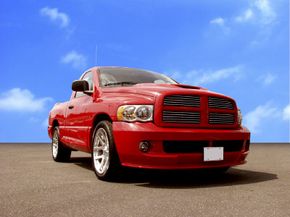
There's no denying it: Trucks and SUVs are big -- excessively big, in some cases. With that increased size comes increased momentum. This means that trucks and SUVs need more stopping power than a car. So where can they get the stopping power they require? Truck brake calipers. The stopping power of a caliper is determined by its clamping force -- the amount of force it can apply to the surface of a rotor. This is primarily a function of the number of pistons and the surface area of the brake pad (where it actually contacts the rotor). Obviously, a caliper with a greater clamping force is capable of slowing or stopping a vehicle easier and faster than a caliper that has a lower clamping force.
Many trucks come from the factory with basic floating calipers that provide sufficient clamping power for the vehicle as it's delivered to the dealer. However, when the truck is customized with larger tires and heavy accessories, and when a substantial load of cargo is brought on board, these factory-installed calipers might not be powerful enough to provide the braking power the truck needs. Fortunately, there's a substantial aftermarket for truck calipers. From the manufacturer, a truck might have calipers that provide in the neighborhood of 5,000 square millimeters (7.8 square inches) of surface area between the pistons and the rotor. An aftermarket caliper can more than double that surface area, providing the clamping force required by a fully customized vehicle.
Advertisem*nt
More than most brake parts, truck brake calipers have to deal with a lot of heat. Heat is bad for brakes because it can lead to brake fade and reduced stopping distances. Good ventilation in the caliper is essential for continuous, consistent brake performance. In addition, a larger brake rotor (or brake disc) surface can also help spread the heat over a larger area.
Trucks and SUVs aren't the only vehicles that require special brake equipment; however, the calipers in these heavy-weight vehicles do have a difficult job to perform. Some might even say that truck brake calipers should be considered high-performance brake calipers. In the next section we'll look at some of the features that high-performance brake calipers can offer other vehicles.
Advertisem*nt
Performance Brake Calipers
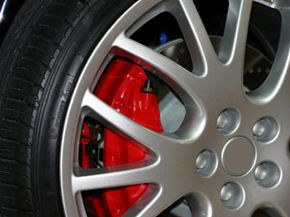
Disc brakes were originally developed for race cars. Everyone knows that race cars move along at high speeds -- but they also need to decelerate rapidly. In the early days of racing, when most cars were equipped with drum brake systems, brake fade led to a number of on-track mishaps. Disc brake systems were better ventilated, and as a result, reduced some of the stress that racing and excessive heat
build-up can cause -- in turn, reducing (but not eliminating) brake fade. In time, these powerful brakes trickled down to less performance-oriented vehicles. Now, they're even found on most economy cars. Nonetheless, high-performance cars are still a major market for better and more powerful brakes, and variations on the basic brake caliper design help these brakes provide superior stopping power.
Advertisem*nt
There are certain limitations to just how much the vehicle's brakes and its calipers can do to stop a vehicle; while they may be able to bring the wheels to a stop, it's up to the gripping power of the tires to do the rest, and improved brake parts can't help beyond a certain point. However, there are several ways in which brake calipers can be (and have been) improved. Some common features found in performance brake calipers include:
- Bigger pistons -- The larger the pistons are, and the greater the area over which they come in contact with the brake pads, the more clamping force they have on the rotor.
- More pistons -- Low-end floating brake calipers have a single piston, on the inboard side. Low-end fixed calipers have a single pair of pistons, flanking the rotor disc. High-performance calipers can have multiple pins or pairs of pins, mounted on opposing sides of the rotor. Six-piston models are increasingly common and even 12-piston models are not unheard of. Increasing the number of pistons also serves to increase the clamping force of the caliper.
- Less heat retention -- In a sense, your brakes can be thought of as a device for converting movement into heat. As the vehicle slows down, all of that kinetic energy has to go somewhere and most of it ends up as heat. If you want to look at it another way, all that friction between the brake pads and the rotor generates heat in much the same way that striking a match generates heat. If too much heat builds up, the brakes begin to fade, or become less effective. So, the better ventilated the brake calipers are, the better they perform. Also, the larger the surface of the brake rotor, the more the heat is spread out.
- Differential bore calipers -- As the surface of the rotor heats up, the clamping force of the pistons has to be increased to avoid brake fade. If the caliper has multiple pistons (or multiple pairs of pistons), the brake rotor surface is initially heated by the pistons pushing against the brake pad at the leading edge of the caliper, making the rotor surface hotter when it rotates back to the pistons closer to the trailing edge of the caliper. Therefore it helps if the pistons closer to the rear edge of the caliper are larger. Differential-bore calipers use smaller pistons up front, larger pistons toward the back.
All of these technologies can increase the braking power provided by a caliper. For smaller cars that typically aren't driven at high speeds, this extra braking power isn't really necessary. However, the faster and more powerful a vehicle is, the more it will benefit from high-performance calipers.
Advertisem*nt
Brake Calipers FAQ
What is the function of brake calipers?
Brake calipers are a crucial component of a car’s braking system that help reduce the spin of the rotor inside the wheel to halt the vehicle. When brakes are applied, the calipers squeeze and press the pads in an effort to reduce the speed of the vehicle, performing the braking operation.
How much does it cost to replace calipers?
On average, you will pay around $525 to $760 to get your calipers replaced. The cost of the new parts might range from around $390 to $590 excluding the taxes. This does not include the labor fee, which will vary based on your location.
What happens when a brake caliper goes bad?
When your calipers are worn out, the brake pads will wear unevenly. If they are thinner on one side, this might be a sign of a run-down caliper. Another sign could be reduced brake power when you press the pedal.
Why do some cars have red brake calipers?
Red brake calipers are relatively expensive and are used on high-end vehicles such as Ferrari, Porsche, Koenigsegg, Mustang and Bugatti to name a few. Red brakes are also called high-performance brakes or sports brakes.
How much does it cost to have brake calipers painted?
It depends on the types of paint used. Typically, if you’re getting your calipers painted from a professional workshop, it might cost you around $250 to $450. Additionally, if you’re using top-quality specialty paint, you can expect to add $200 per caliper to your bill.
Lots More Information
Related HowStuffWorks Articles
- How Brake Pads Work
- How Brake Rotors Work
- How does payload affect braking?
- How to Paint Brake Calipers
More Great Links
Sources
- CadillacFAQ.com. "How do I change my own brake pads?" (Nov.12, 2008) http://www.cadillacfaq.com/faq/answers/bpadchange/index.html
- Carley, Larry. "Loaded Brake Calipers." AA1Car.com. 2004. (Nov. 12, 2008) http://www.aa1car.com/library/2004/bf20426.htm
- Continental Corporation. "Twin-sliding calipers with composite brake disc deliver optimum braking performance with fascinating comfort." 6/8/2006. (Nov. 12, 2008) http://www.conti-online.com/generator/www/com/en/continental/portal/themes/ press_services/press_releases/products/automotive_systems/pr_2006_06_08_ twin_sliding_calipers_en.html
- Tyagi, Parshant. "Finite Element Analysis of Innovated Design of Racing Brake Calipers." December 2006. (Nov. 12, 2008) http://soar.wichita.edu/dspace/bitstream/10057/1181/1/t07057.pdf